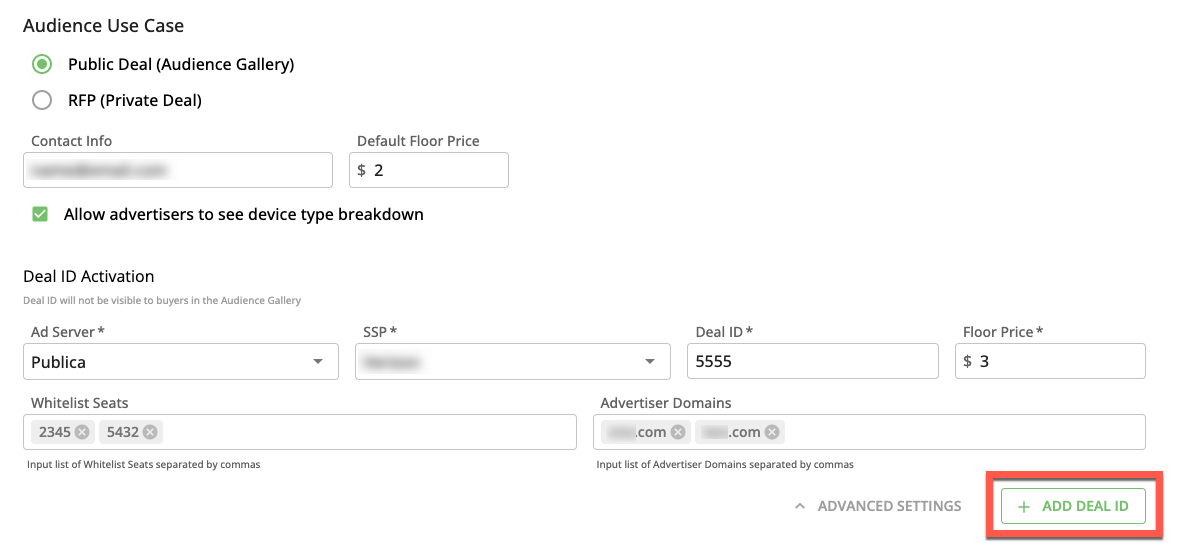The Audience Builder Page (OTT Hub)
Caution
This article is intended for users of the OTT Hub. If you are not an OTT Hub user, see the article "The Audience Builder Page" in our main Advanced TV section.
From the Audience Builder page, you can see all the data loaded in your account, search that data, build segments from that data, and continually edit and refine your segments until you are ready to save an audience from those segments. See “Build an Audience” for instructions on audience-building tasks.
To access the Audience Builder page for OTT Hub, click Audience Builder in the OTT Hub section of the Advanced TV navigation menu.

The Audience Builder page is divided into four areas:
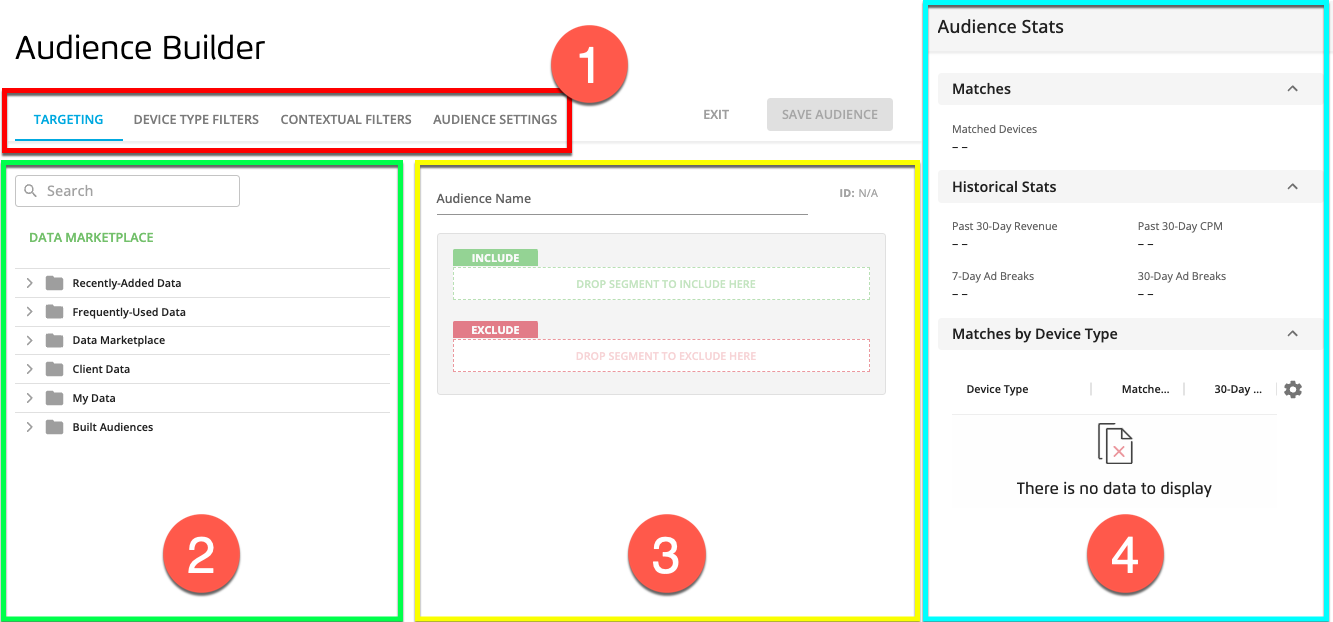
The tabs area (which defaults to the TARGETING tab, but includes the DEVICE TYPE FILTERS tab and the AUDIENCE SETTINGS tab)
The data area
The sandbox area
The Audience Results side panel
The Data Area
From the TARGETING tab, the left hand side of this screen is the data area, which contains all the data you can use to build audiences. You can click the carets to expand the folders and subfolders, or if you already know the data you want to use, you can use the Search bar to search for that data. You can also perform an advanced search that includes one or more search filters by clicking the advanced search icon in the search bar (see "Perform an Advanced Search in a Builder" for more information).
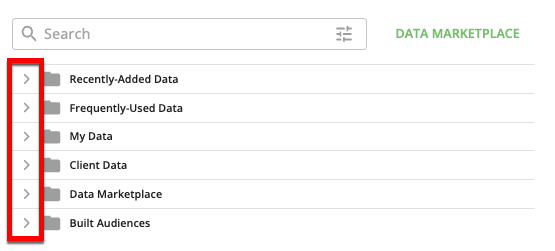
Available folders:
Recently-Added Data: This contains up to 30 of the most recently-added segment categories, in descending order with most recently added first.
Note
The segment categories displayed in this folder have been duplicated from their original folder location, and have not been moved from their original folder location.
Frequently-Used Data: This contains up to 30 of the segment categories most frequently added to audiences in the last 3 months, in descending order with the most frequently used displayed first.
Note
The segment categories displayed in this folder have been duplicated from their original folder location, and have not been moved from their original folder location.
My Data: This contains your files (such as subscriber or viewer files). Depending on how you process your data, you may have more than one.
Data Marketplace: This contains data (typically third-party) from the LiveRamp Data Marketplace that is approved for TV targeting, and is offline based (or modeled beforehand).
Note
Don't see the type of Data Marketplace data that you need? Click DATA MARKETPLACE to navigate to the Data Marketplace in your Connect account.
If you aren't finding the Data Marketplace segments that fit your needs, LiveRamp's Audience Solutions team can help suggest data providers that are best suited to your goals, across diverse data sets like demo, location, behavior, and more. Email the Audience Solutions team at DataMarketplace@liveramp.com to get started.
Client Data: This contains advertiser data that has been distributed from within the Connect UI to your account in Advanced TV.
TV ID Audiences: If you’ve requested ZIP code segments be made from your base universe, this contains those segments. See “Announcing MVPDs Can Now Build Audiences Utilizing ZIP Codes (3/16/20)” for more information.
Built Audiences: This contains every audience that has previously been built in this account. This allows users to either target or suppress a group of people that have been defined in another audience. This functionality is useful to ensure test and control groups do not become intermingled when running many related campaigns.
Note
Seeing different match counts? The match count you see for an audience on the Audience Builder page might be different from the one you see on the Audiences page. Once an audience has been distributed, the match count on the Audiences page is frozen, whereas the match count on the Audience Builder page is updated when the subscriber files are refreshed.
Caution
Data merging limitations: We do not currently allow merging across multiple advertiser's first-party sources.
Note
To display all of the available values within a given segment category, click the caret to the left of the segment category name.
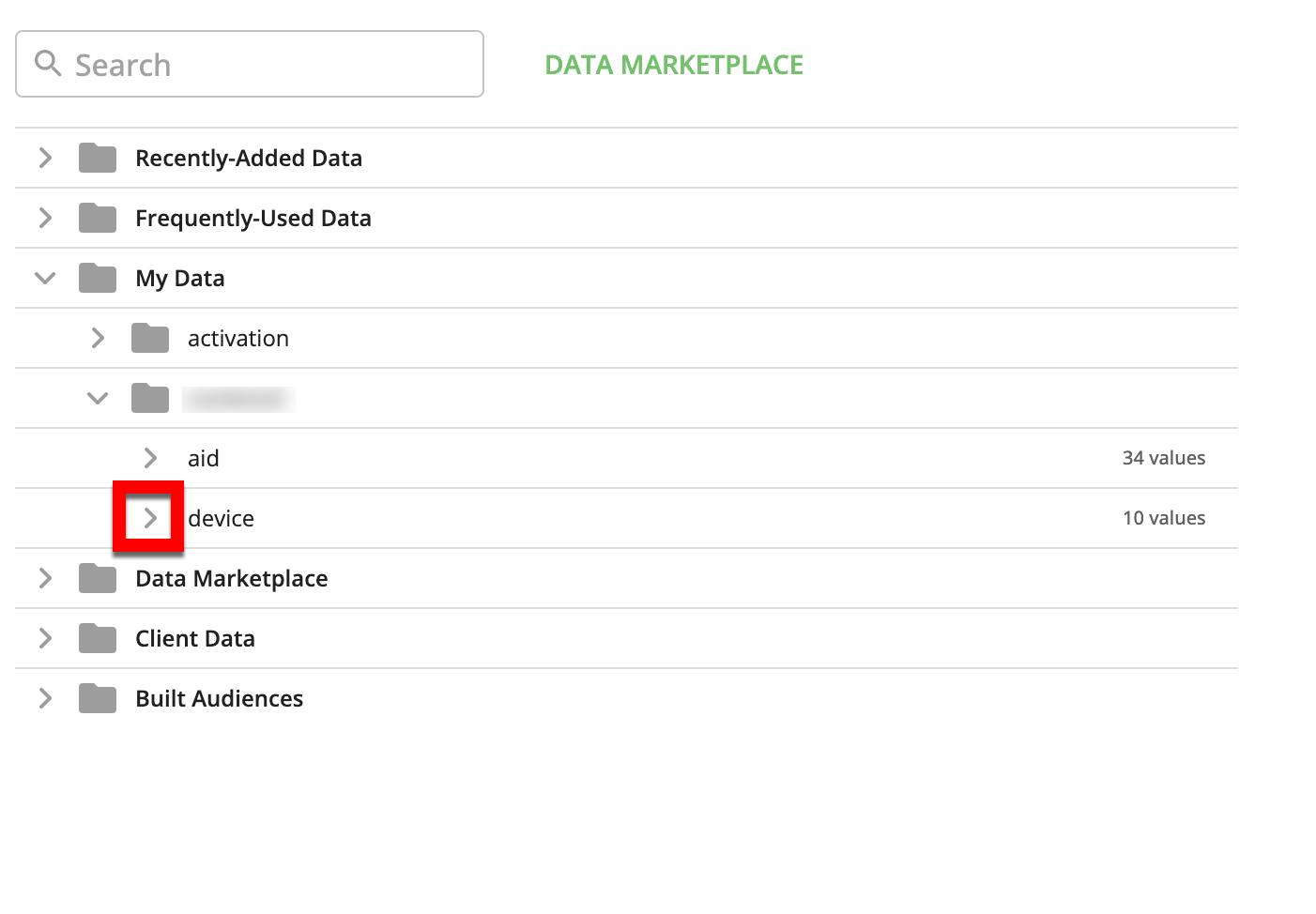
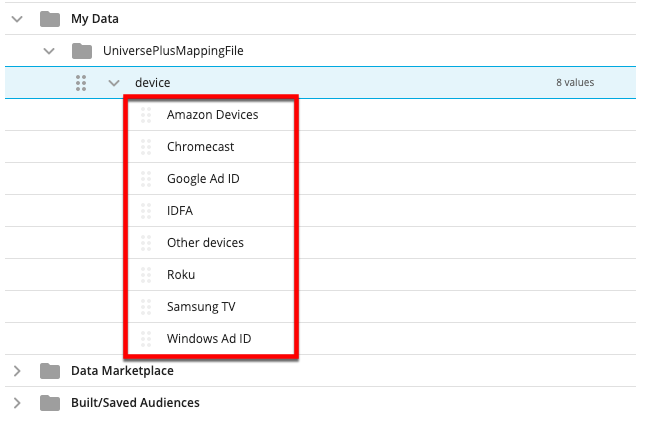
You can also click anywhere in the segment row to open a panel below the folder tree. For Data Marketplace segments, the panel will also display a segment description and the CPM for each segment value.
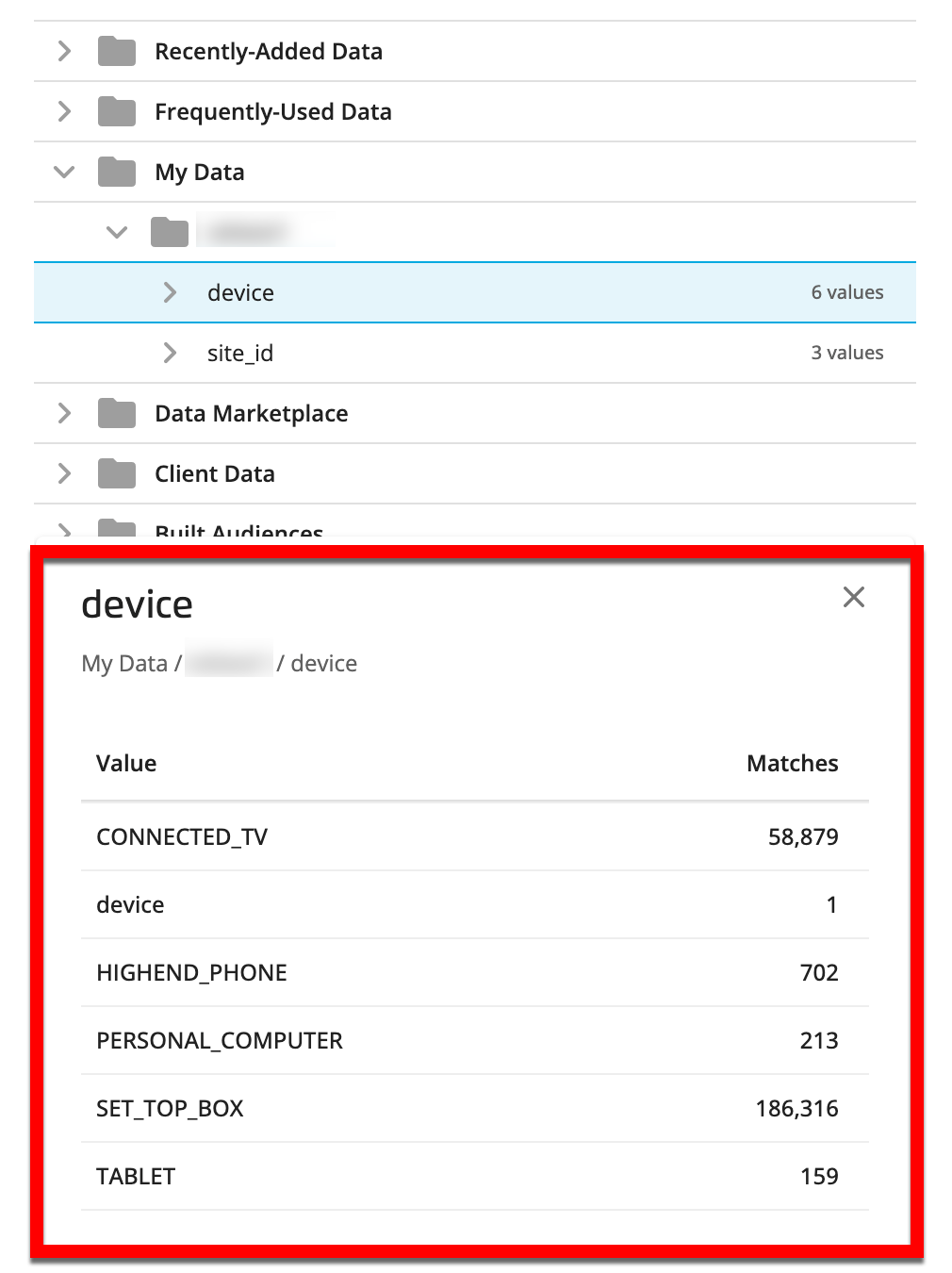
When building an audience, you can drag either a segment category or a specific segment value into the sandbox area:
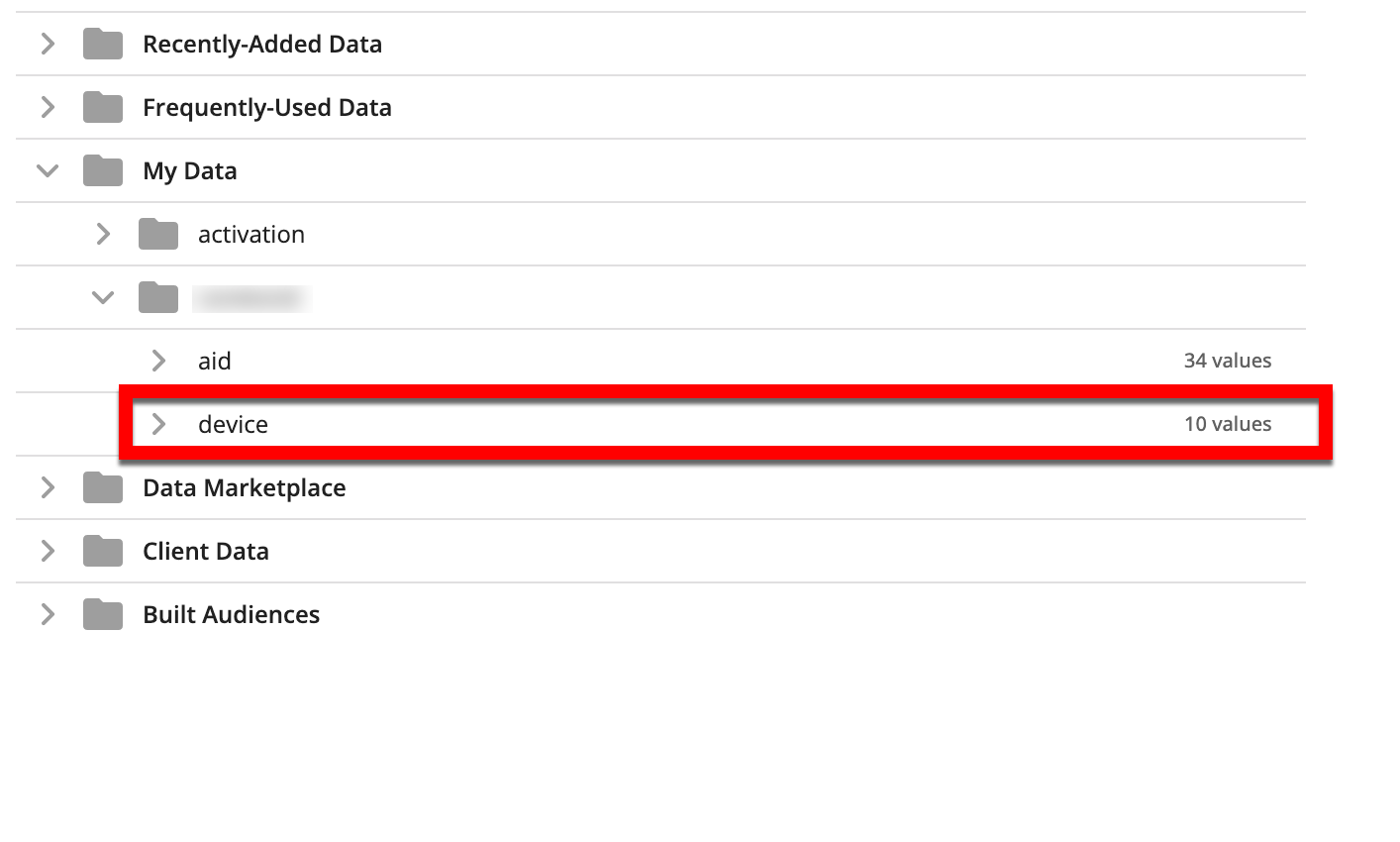
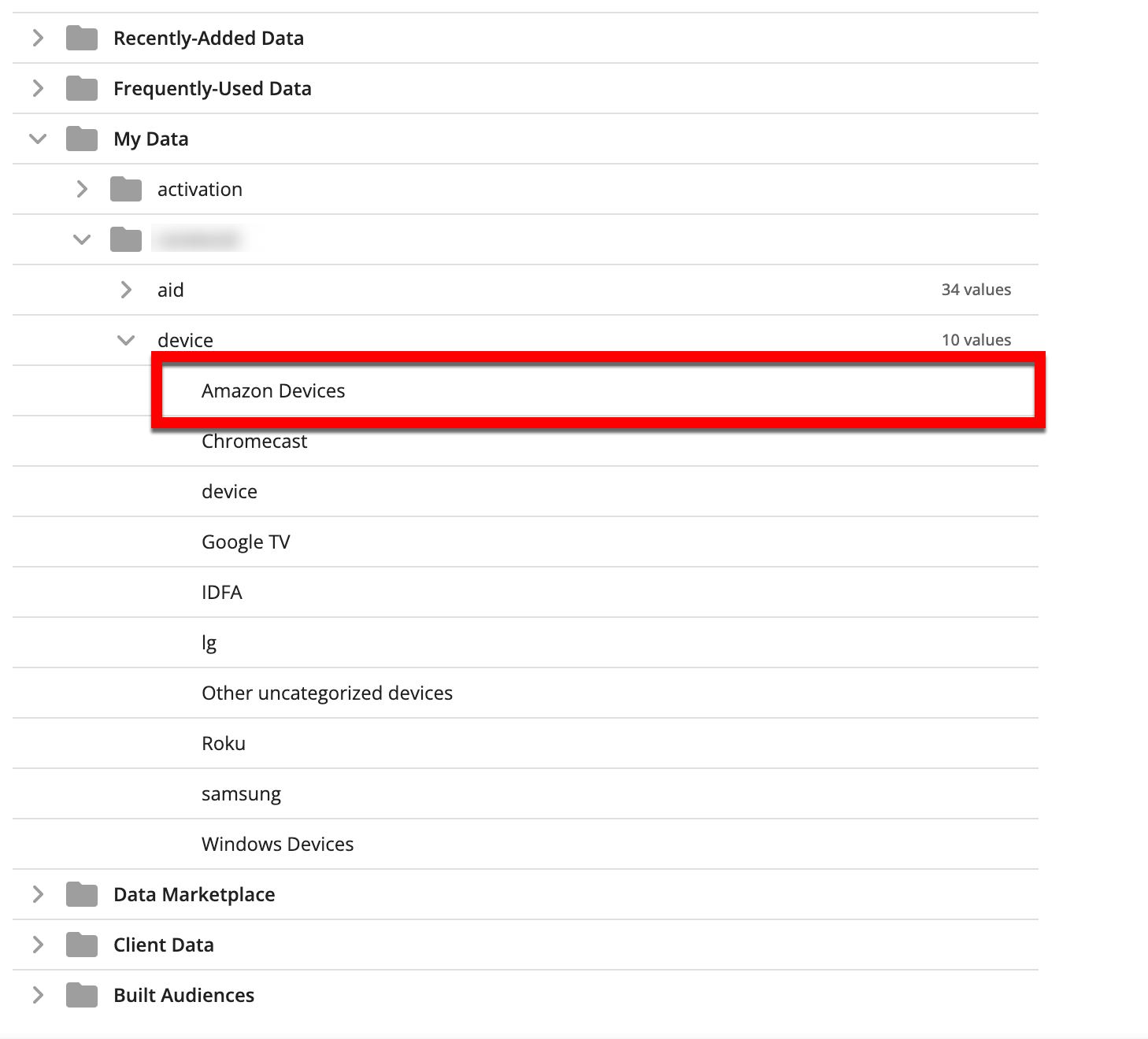
Note
When you drag a segment category, all of the values for that category are included by default. You can click the caret in the row for the segment you just created to display the list of all values for that category and then select or deselect any desired values. If the category contains seven or more values, you can also use the search bar or the select all/clear all functionality.
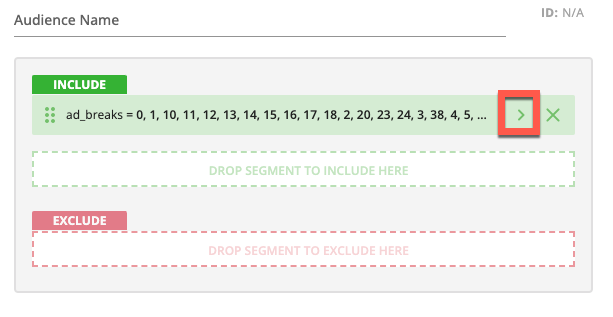
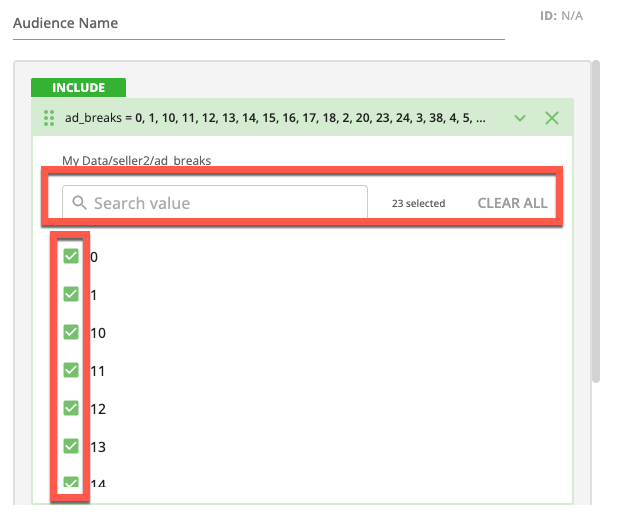
Note
You can select multiple segment categories and/or segment values and then drag them into the box as a group.
The Sandbox Area
From the TARGETING tab, the sandbox area is the area you use to build an RFP.
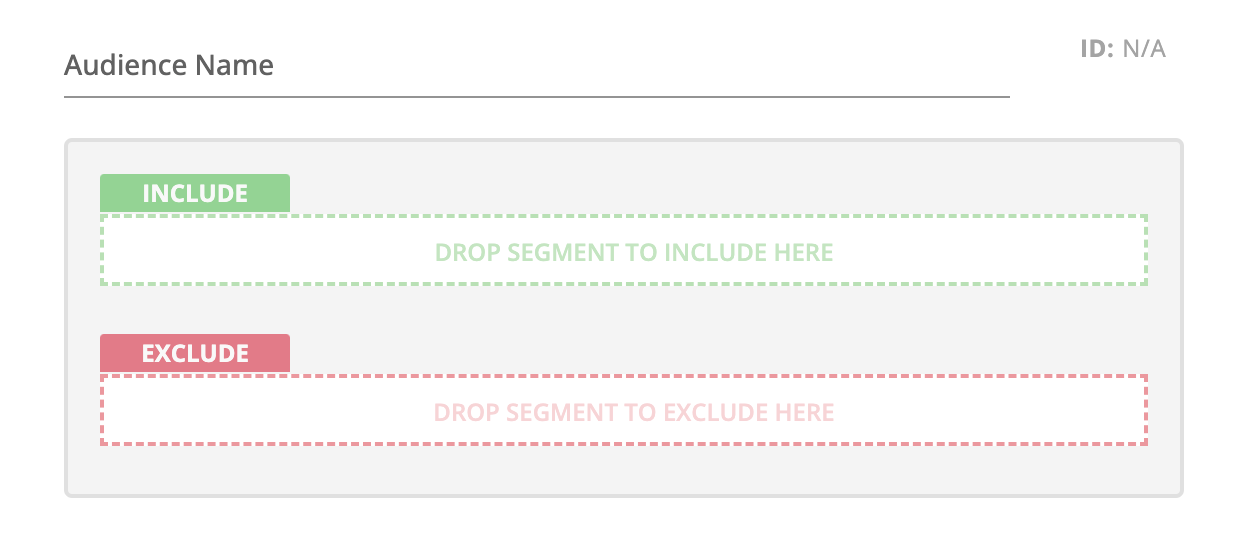
You start by dragging a segment category or value into the INCLUDE box in the sandbox.
Note
You can also use a previously-created audience as a component of your new audience by opening the "Built RFPs" folder. However, no segment values will appear.
When you drag a segment category, all of the values for that category are included by default. You can click the caret in the row for the segment you just created to display the list of all values for that category and then select or deselect any desired values. If the category contains seven or more values, you can also use the search bar or the select all/clear all functionality.


If you want to exclude certain members (or devices) from the audience, drag an additional segment category or value into the EXCLUDE box, and then select or deselect any segment value check box(es) to adjust the values included in the segment (unless you've dragged a previously-created audience from the "Built Audiences" folder).
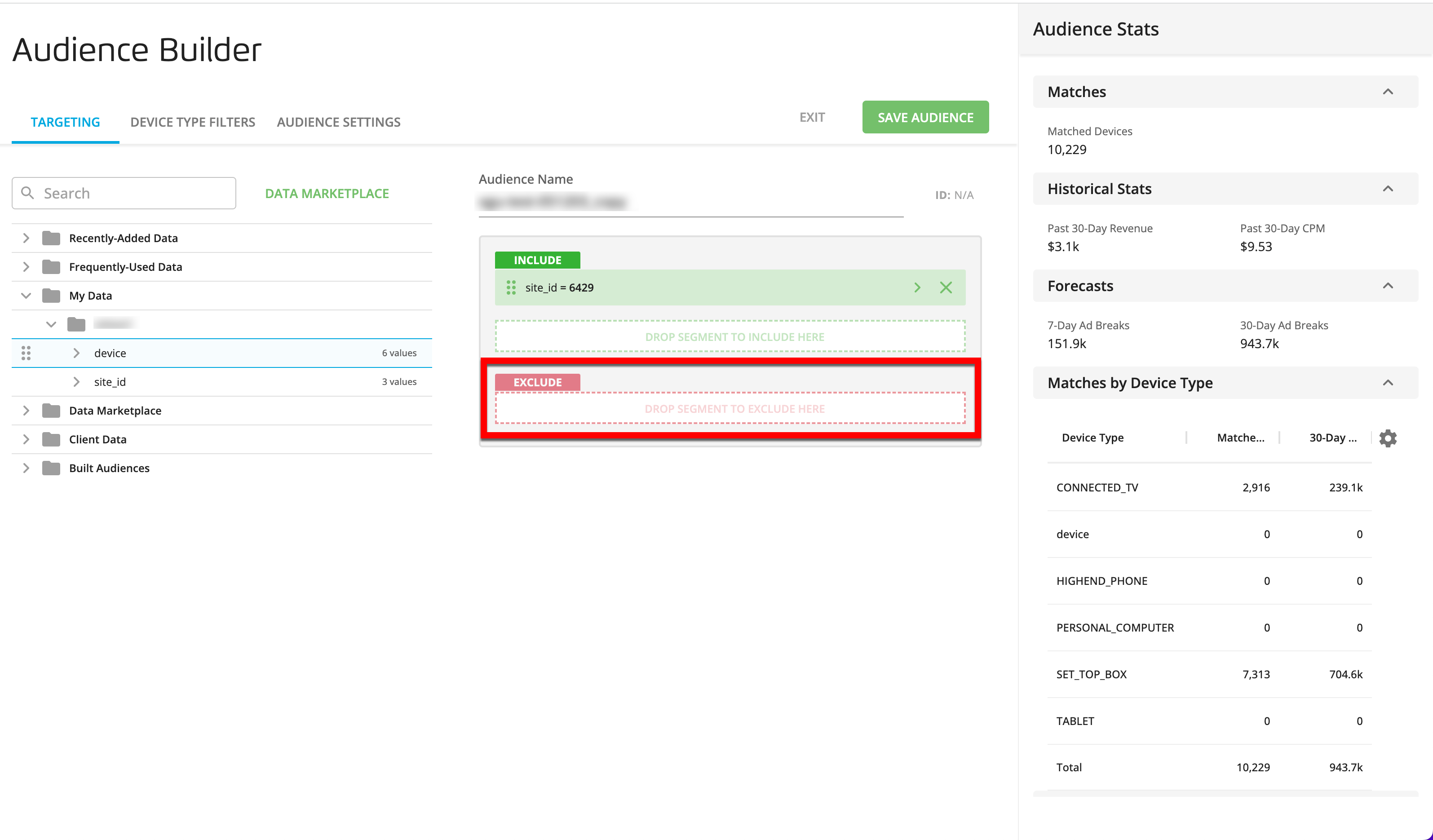
Note
The individual segment components in the same segment box can be joined either by “And” (to include only subscribers or devices who are in both categories) or “Or” (to include all subscribers or devices who are in at least one of the included categories). Click the AND/OR selector to change the join method.
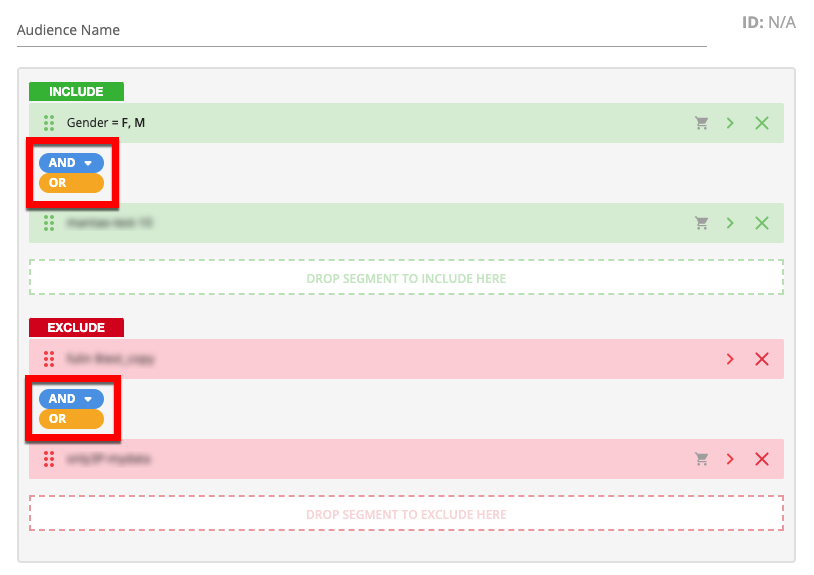
Use the Audience Name field to enter a name for the audience.
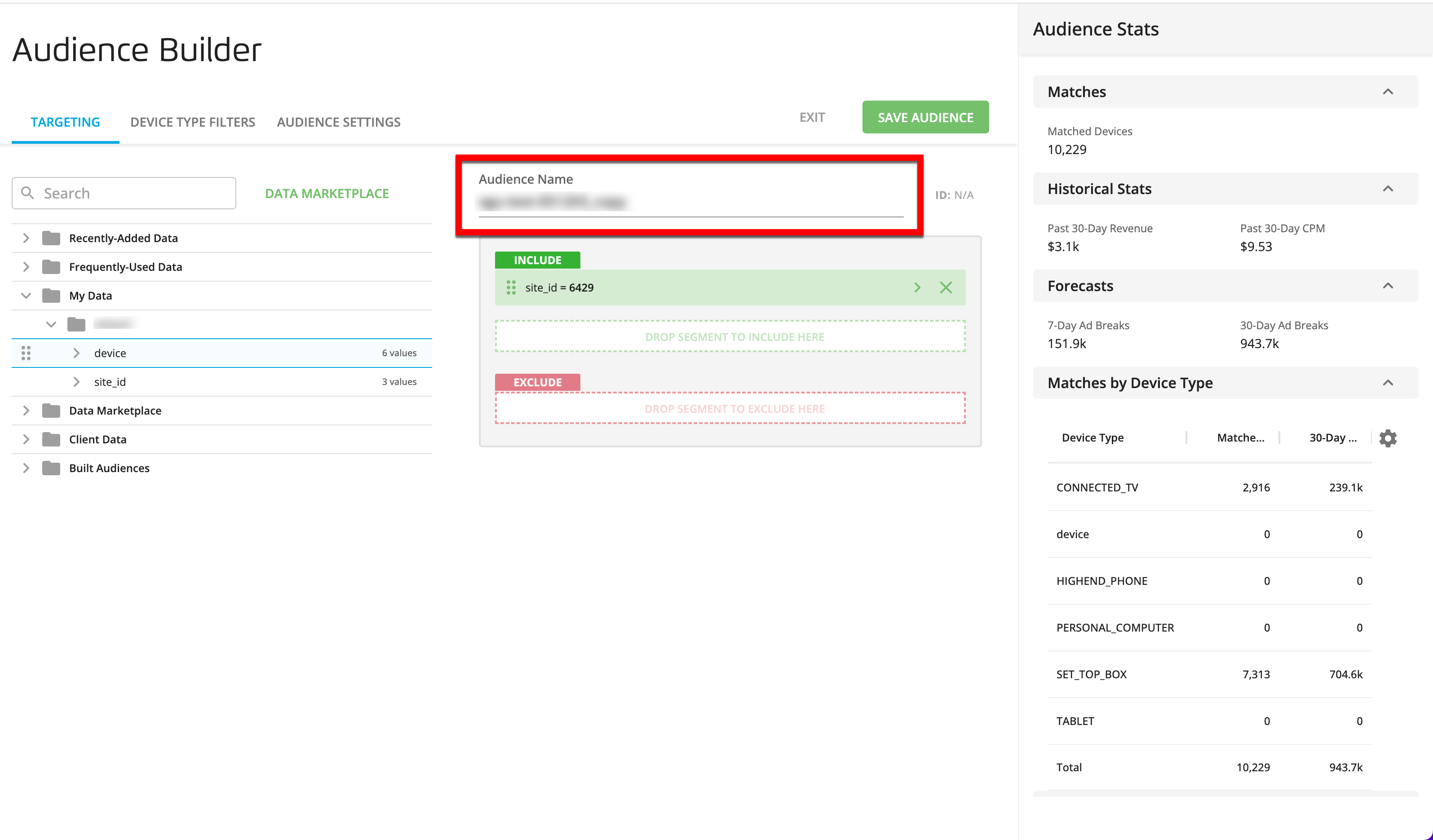
Caution
The audience name can only contain letters, numbers, hyphens, or underscores, and cannot be longer than 240 characters. The name cannot contain spaces.
See “Build an RFP” for more information.
The Audience Results Side Panel
The Audience Results side panel displays the following metrics for the audience (these metrics adjust as you adjust the audience):
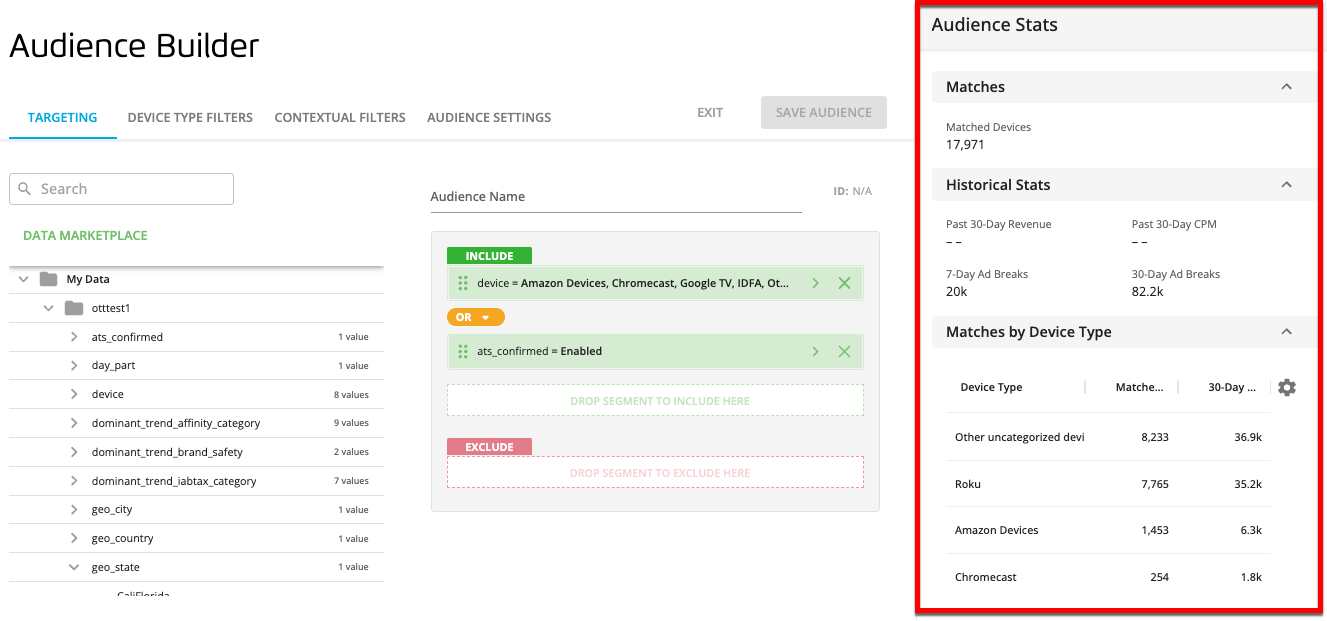
Matched Devices: The number of devices matched to this audience.
Past 30-Day Revenue: The total revenue generated by all devices matched to this audience in the past 30 days.
Past 30-Day CPM: The average CPM paid in the past 30 days in bidding on the devices matched to this audience.
7-Day Ad Break: Our forecast of the number of potential ad impressions that might be shown for the devices in this audience over 7 days. See "Forecasting" for more information.
30-Day Ad Breaks: Our forecast of the number of potential ad impressions that might be shown for the devices in this audience over 30 days. See "Forecasting" for more information.
Matches by Device Type: A table showing the number of matched devices and ad breaks for each device.
Note
Click the gear icon to select whether the table shows 7-day ad breaks or 30-day ad breaks.
Activation Data Cost (CPM): The cost of activating this audience via LiveRamp, which includes the LiveRamp Matching Fee (CPM) and the Data Marketplace CPM (the highest CPM of all including Data Marketplace segments. Hover over the number to see a breakdown of this cost.
Any stats that have been affected by a filter are displayed with a funnel icon, along with a tooltip that shows what the stat would be if filters were not applied:

See "Applying Contextual Filters" for more information.
The DEVICE TYPE FILTERS Tab
The DEVICE TYPE FILTERS tab displays the available device types, along with the number of matched devices per type and the 7-day and 30-day ad break. You can change the device types that will be included in the audience by adjusting the "Include in Audience" toggles for the device types you want to adjust (all device types are included by default).
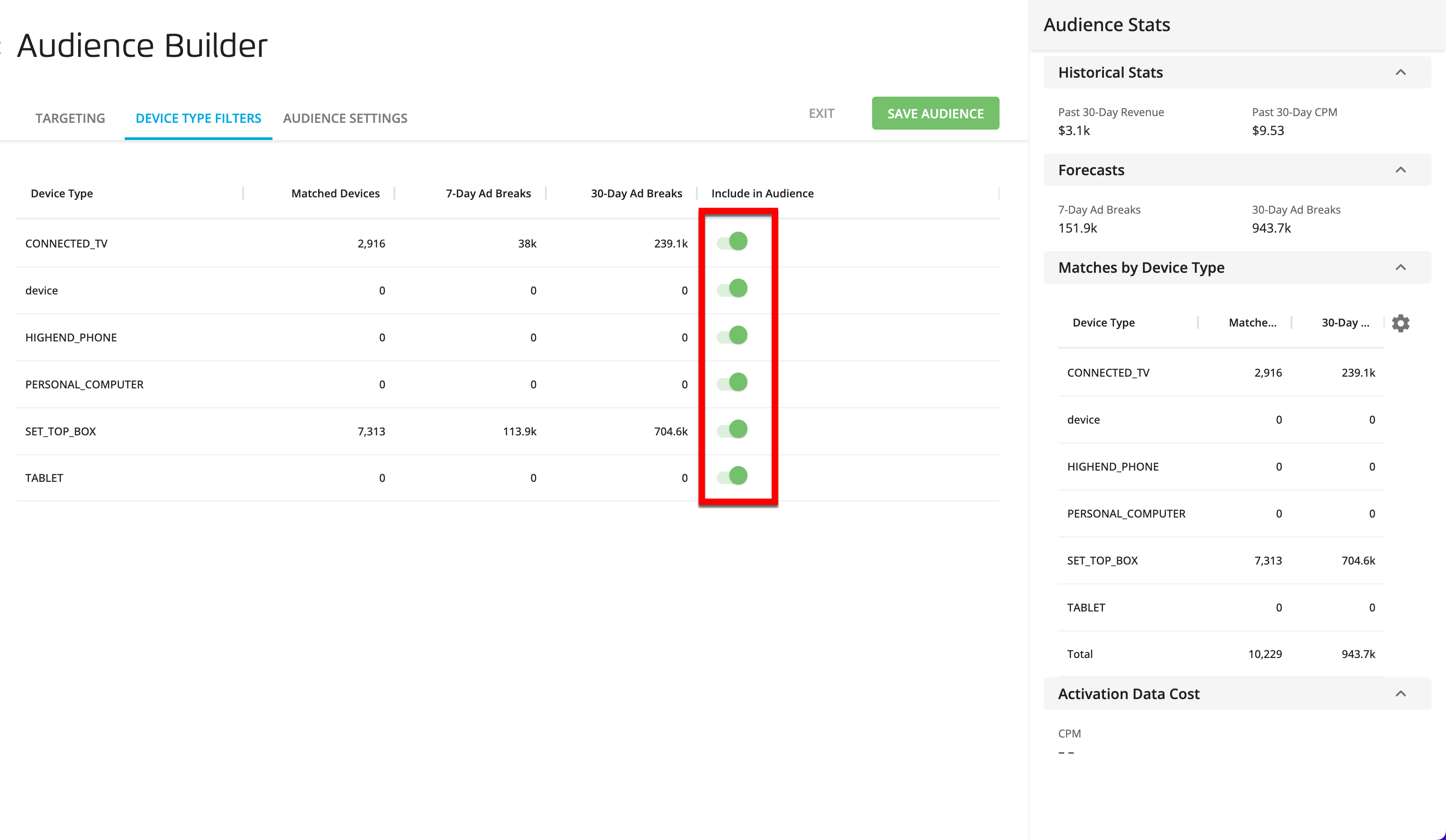
The CONTEXTUAL FILTERS Tab
The CONTEXTUAL FILTERS tab allows you to add contextual filters to the audience:
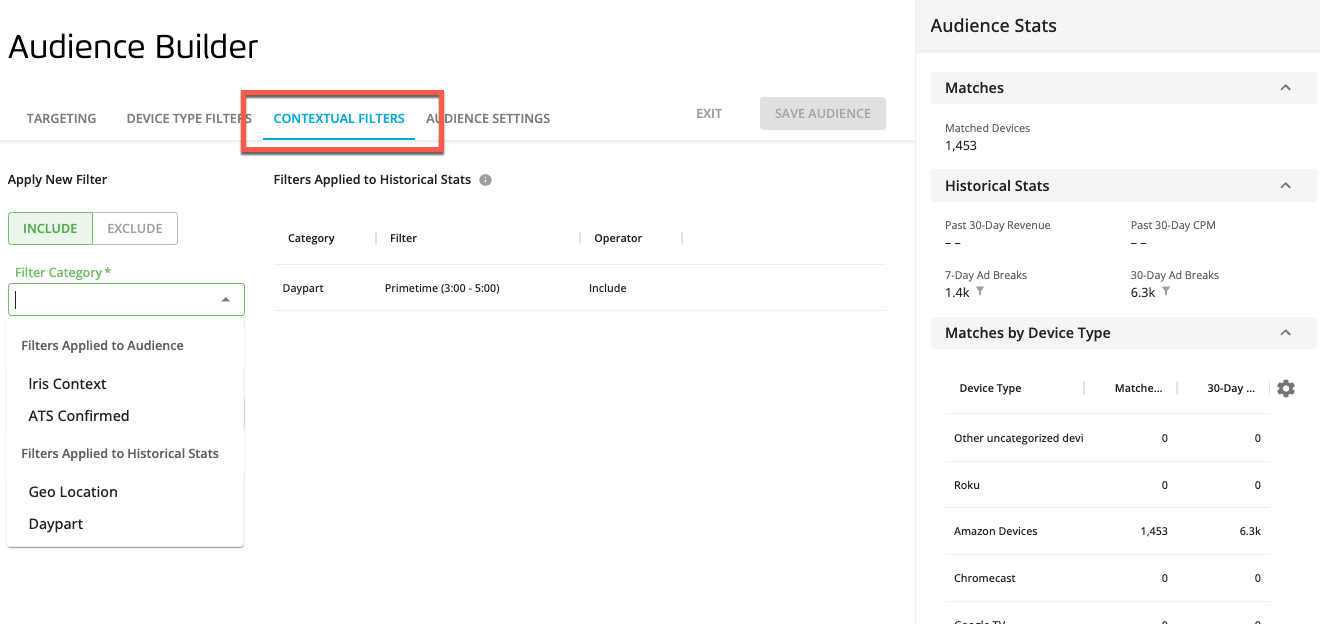
See "Applying Contextual Filters" for more information.
The AUDIENCE SETTINGS Tab
The RFP SETTINGS tab allows you to add RFP settings:
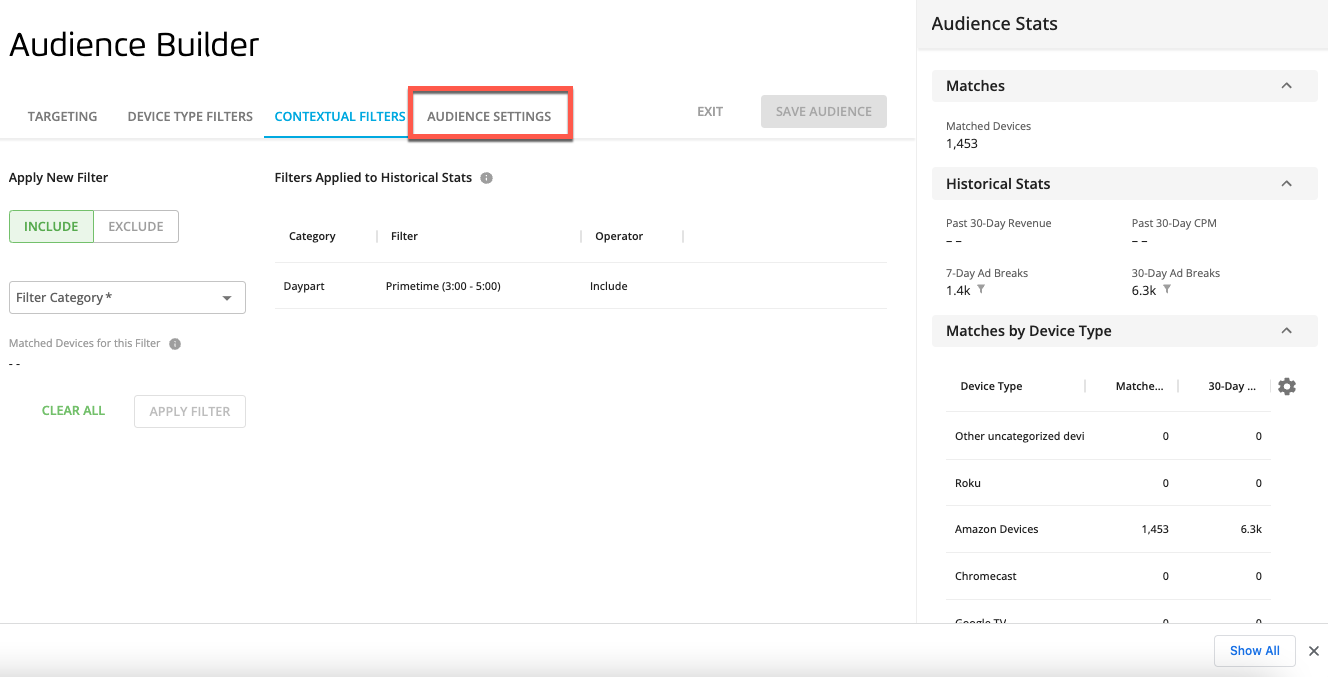
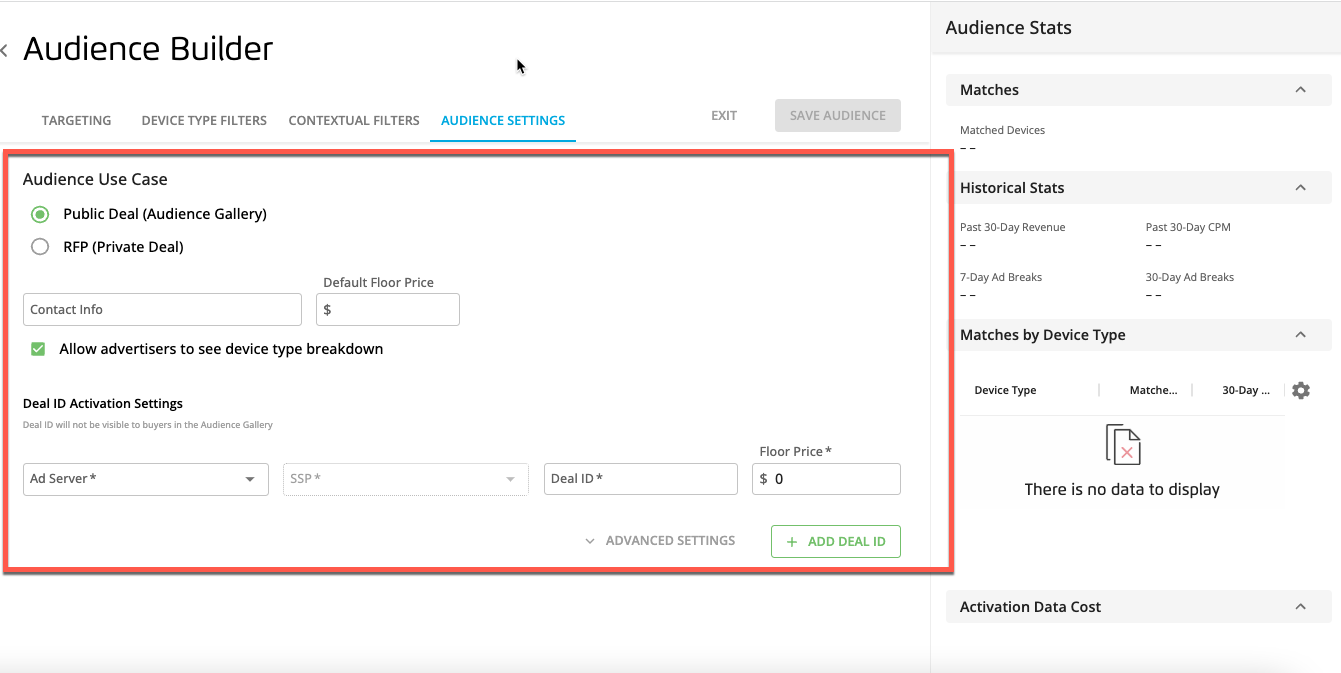
Audience Use Case: "Public Deal (Audience Gallery)" or "RFP "
Advertiser: For RFP use cases, enter the advertiser this audience is being built for.
Contact Info: The email address of the person to contact to obtain a Deal ID for the audience.
Default Floor Price: The default minimum ad price that can be executed (configured at the ad server).
To allow the advertiser to see a breakdown of device types and choose which device types (for pubic deals), check the "Allow advertisers to see device type breakdown" check box.
Deal ID Activation:
Ad server
SSP
Deal ID
Floor price (used to set a floor price different from the default floor price)
Advanced Deal ID Activation Settings:
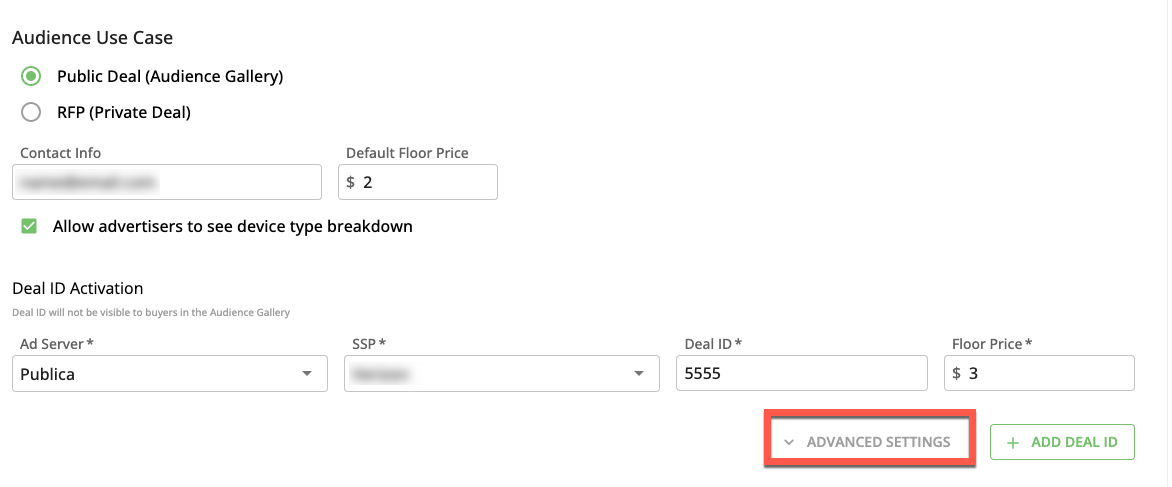
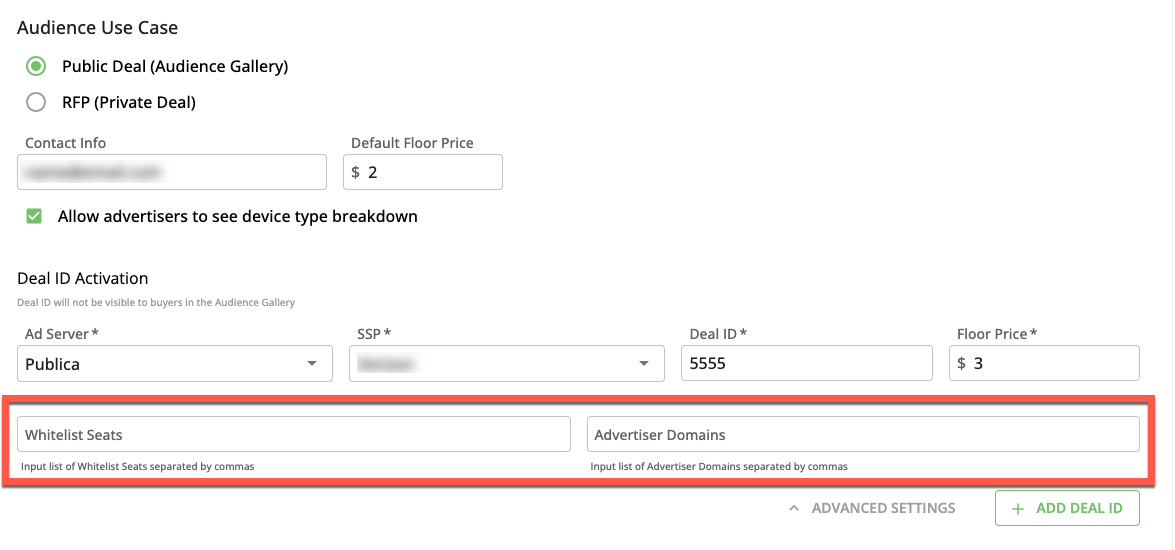
Whitelist seats
Whitelist Advertiser Domains
Clicking allows you to enter additional deal ID information.
